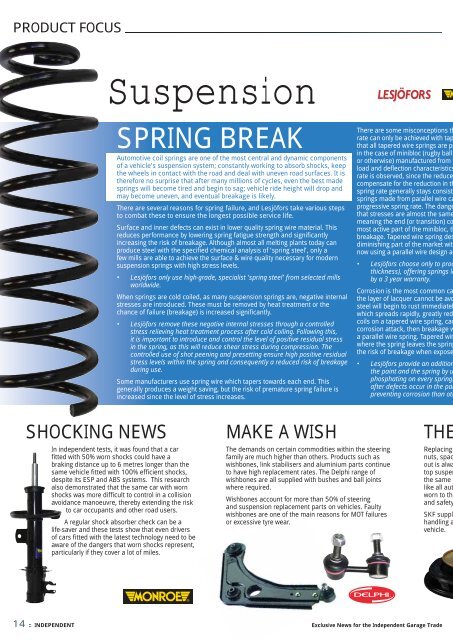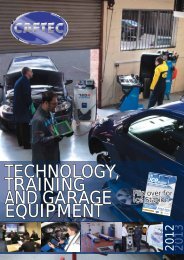issue 63 - Camberley Auto Factors Ltd
issue 63 - Camberley Auto Factors Ltd
issue 63 - Camberley Auto Factors Ltd
You also want an ePaper? Increase the reach of your titles
YUMPU automatically turns print PDFs into web optimized ePapers that Google loves.
PRODUCT FOCUS<br />
Suspension<br />
SPRING BREAK<br />
<strong>Auto</strong>motive coil springs are one of the most central and dynamic components<br />
of a vehicle’s suspension system; constantly working to absorb shocks, keep<br />
the wheels in contact with the road and deal with uneven road surfaces. It is<br />
therefore no surprise that after many millions of cycles, even the best made<br />
springs will become tired and begin to sag; vehicle ride height will drop and<br />
may become uneven, and eventual breakage is likely.<br />
There are several reasons for spring failure, and Lesjöfors take various steps<br />
to combat these to ensure the longest possible service life.<br />
Surface and inner defects can exist in lower quality spring wire material. This<br />
reduces performance by lowering spring fatigue strength and significantly<br />
increasing the risk of breakage. Although almost all melting plants today can<br />
produce steel with the specified chemical analysis of ‘spring steel’, only a<br />
few mills are able to achieve the surface & wire quality necessary for modern<br />
suspension springs with high stress levels.<br />
• Lesjöfors only use high-grade, specialist ‘spring steel’ from selected mills<br />
worldwide.<br />
When springs are cold coiled, as many suspension springs are, negative internal<br />
stresses are introduced. These must be removed by heat treatment or the<br />
chance of failure (breakage) is increased significantly.<br />
• Lesjöfors remove these negative internal stresses through a controlled<br />
stress relieving heat treatment process after cold coiling. Following this,<br />
it is important to introduce and control the level of positive residual stress<br />
in the spring, as this will reduce shear stress during compression. The<br />
controlled use of shot peening and presetting ensure high positive residual<br />
stress levels within the spring and consequently a reduced risk of breakage<br />
during use.<br />
Some manufacturers use spring wire which tapers towards each end. This<br />
generally produces a weight saving, but the risk of premature spring failure is<br />
increased since the level of stress increases.<br />
SHOCKING NEWS MAKE A WISH THE<br />
14 :: INDEPENDENT<br />
In independent tests, it was found that a car<br />
fitted with 50% worn shocks could have a<br />
braking distance up to 6 metres longer than the<br />
same vehicle fitted with 100% efficient shocks,<br />
despite its ESP and ABS systems. This research<br />
also demonstrated that the same car with worn<br />
shocks was more difficult to control in a collision<br />
avoidance manoeuvre, thereby extending the risk<br />
to car occupants and other road users.<br />
A regular shock absorber check can be a<br />
life-saver and these tests show that even drivers<br />
of cars fitted with the latest technology need to be<br />
aware of the dangers that worn shocks represent,<br />
particularly if they cover a lot of miles.<br />
The demands on certain commodities within the steering<br />
family are much higher than others. Products such as<br />
wishbones, link stabilisers and aluminium parts continue<br />
to have high replacement rates. The Delphi range of<br />
wishbones are all supplied with bushes and ball joints<br />
where required.<br />
Wishbones account for more than 50% of steering<br />
and suspension replacement parts on vehicles. Faulty<br />
wishbones are one of the main reasons for MOT failures<br />
or excessive tyre wear.<br />
There are some misconceptions th<br />
rate can only be achieved with tap<br />
that all tapered wire springs are pr<br />
in the case of minibloc (rugby ball<br />
or otherwise) manufactured from t<br />
load and deflection characteristics<br />
rate is observed, since the reduce<br />
compensate for the reduction in th<br />
spring rate generally stays consiste<br />
springs made from parallel wire ca<br />
progressive spring rate. The dange<br />
that stresses are almost the same<br />
meaning the end (or transition) co<br />
most active part of the minibloc, th<br />
breakage. Tapered wire spring des<br />
diminishing part of the market wit<br />
now using a parallel wire design as<br />
• Lesjöfors choose only to prod<br />
thickness), offering springs le<br />
by a 3 year warranty.<br />
Corrosion is the most common ca<br />
the layer of lacquer cannot be avo<br />
steel will begin to rust immediatel<br />
which spreads rapidly, greatly red<br />
coils on a tapered wire spring, car<br />
corrosion attack, then breakage w<br />
a parallel wire spring. Tapered wir<br />
where the spring leaves the spring<br />
the risk of breakage when expose<br />
• Lesjöfors provide an addition<br />
the paint and the spring by u<br />
phosphating on every spring.<br />
after defects occur in the pai<br />
preventing corrosion than oth<br />
Replacing<br />
nuts, spac<br />
out is alwa<br />
top suspen<br />
the same<br />
like all aut<br />
worn to the<br />
and safety<br />
SKF suppl<br />
handling a<br />
vehicle.<br />
Exclusive News for the Independent Garage Trade




